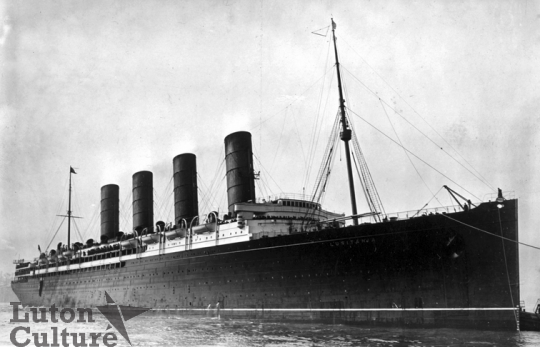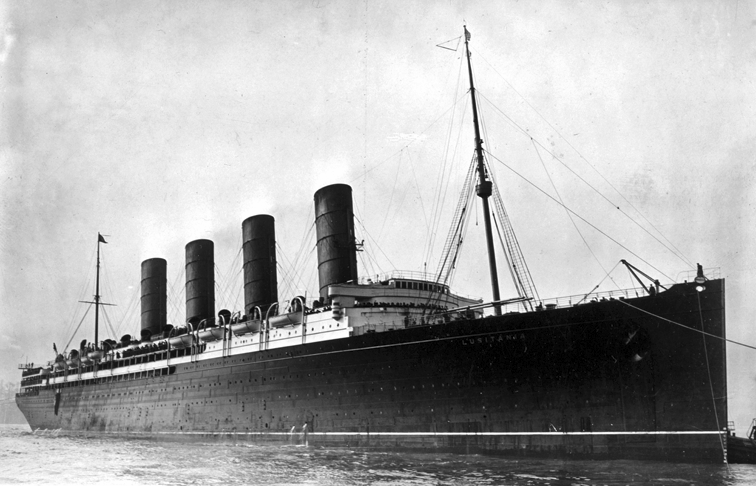Sinking of the Lusitania
Event date
Classifications
Source
Source Date

[Image: Wikimedia]
The sinking on May 7th, 1915, of the British liner RMS Lusitania by a torpedo fired from the German submarine U-20 had repercussions both around the world and for people living in the Luton and Herts area.
Although Germany had declared the seas around Britain a war zone, it was thought when it set sail from New York for Liverpool that the liner's revolutionary new turbine engines that gave a cruising speed of 25 knots would allow it to outrun any submarines. But at 2.10 pm on May 7th a single torpedo found its target off the Old Head of Kinsale, Ireland, with the loss of 1,191 of its 1,962 passengers and crew.
Most immediately affected in Luton was Mr Thomas Bodell, of 95 Clarendon Road, Luton. He lost his son Thomas Edward George Bodell, daughter-in-law Florence and toddler grandson, also named Thomas. His son was returning to England for the first time since moving to, and setting up in business in, Canada ten years earlier.
For Quartermaster Sgt R. Snelling, formerly employed by Hitchin Post Office, news that two of his bride's sisters had perished with the Lusitania marred their wedding day. Serving with the East Anglia Royal Engineers at Newmarket, he had gone to Kenilworth in Warwickshire to marry Miss Annie C. Hopkins, of Kenilworth. The bride's two sisters [Alice Eliza and Kate Mary] had been travelling on the Lusitania to attend the wedding ceremony.
Rather than postpone the ceremony, it was eventually decided to hold a quiet ceremony at St Nicholas Church, Kenilworth - the bride and bridegroom later going to identify the bodies of the sisters.
Writing from the front "somewhere in Belgium," Sgt A. Spink, of the 1/4th Battalion Leicester Regiment (North Midland Division) wrote to Mr and Mrs Harry Gregory, of 9 Leagrave Road, Luton, whose brother had in turn written to him about the Germans celebrating the loss of the Lusitania.
"As soon as the Germans got to know about the Lusitania going down they nearly went off their heads, for we could hear them cheering and shouting, but we soon put a stop to that and made them just the opposite, for we gave them something to do for a long while after," wrote his brother.
Another victim of the sinking of the Lusitania was prominent New York businessman Mr Robert E. Dearbergh, a member of an old-established Dutch family that was at one time well known in Luton, where his brothers carried on one of the leading plait businesses in the town.
Mr F. W. Dearbergh, now of St Albans, learned of his brother's fate from a survivor of the sinking who was being care for in Queenstown [now Cobh in Eire]. The two men had been standing together at the ship's side when the torpedo struck, and the fellow passenger told of the subsequent events.
The passenger remarked , "Look at that streak of bubbles!" Mr Derbergh at once said, "That is a torpedo," and the next minute there was a terrific explosion in the engine room. Such was the power of the missile that it blew its way up through five or six decks of the huge steamer and threw the water and debris sixty feet above the upper deck.
It put the engines immediately out of action, rendering it impossible to stop the liner, which commenced at once to list badly to port. It was impossible to lower the boats on the starboard side owing to the vessel continuing its course. In a very short time there was another explosion, attributed to the boilers bursting, and the water pouring into the vessel was described as being like Niagara.
The great ship heaved over on the starboard side and then a little way back to port took a final plunge bow first into the ocean.
See also - http://www.worldwar1luton.com/event/luton-and-lusitania
[Beds & Herts Saturday Telegraph, May 15th, 1915]
Event Place
Author: Deejaya



Add comment